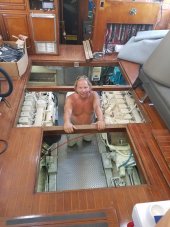Prffsreric
New Member
- Joined
- Jun 3, 2022
- Messages
- 2
I am building a battery for my 48' Sun Deck Trawler. I am stuck on BMS options. The following are the items that I have currently.
The question: Should I go with dumb BMS on every 4 cells or parallel cells into 16 (4s, 4p) or 20 (4s, 5p) and use fewer smart BMS? The price is about the same and I see more protection on the cells with the dumb BMS. What do you think?
System, This is the house battery, 12 volt. I am set with this as everything on the boat is 12V. Electronics, winch, lights, ACC, and charging system.
Battery: 152, 3.4V, 25AH Navitas LifePo4 cells. New.
Inverter: 2500W 12v Sine Wave w/100 amp charger.
House power: 8KW Onan diesel generator. 2 55Amp alternators on main engines.
Solar: Future purchase. 5 panels on hard top. Approximately.
Looking forward to your input!!!
Brett

The question: Should I go with dumb BMS on every 4 cells or parallel cells into 16 (4s, 4p) or 20 (4s, 5p) and use fewer smart BMS? The price is about the same and I see more protection on the cells with the dumb BMS. What do you think?
System, This is the house battery, 12 volt. I am set with this as everything on the boat is 12V. Electronics, winch, lights, ACC, and charging system.
Battery: 152, 3.4V, 25AH Navitas LifePo4 cells. New.
Inverter: 2500W 12v Sine Wave w/100 amp charger.
House power: 8KW Onan diesel generator. 2 55Amp alternators on main engines.
Solar: Future purchase. 5 panels on hard top. Approximately.
Looking forward to your input!!!
Brett



